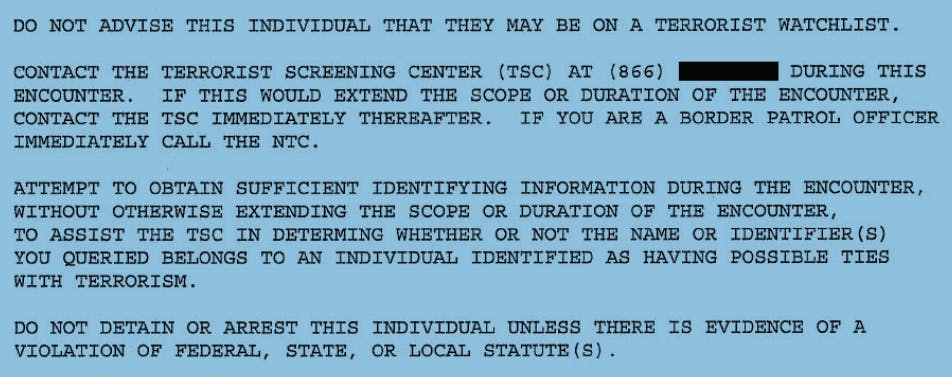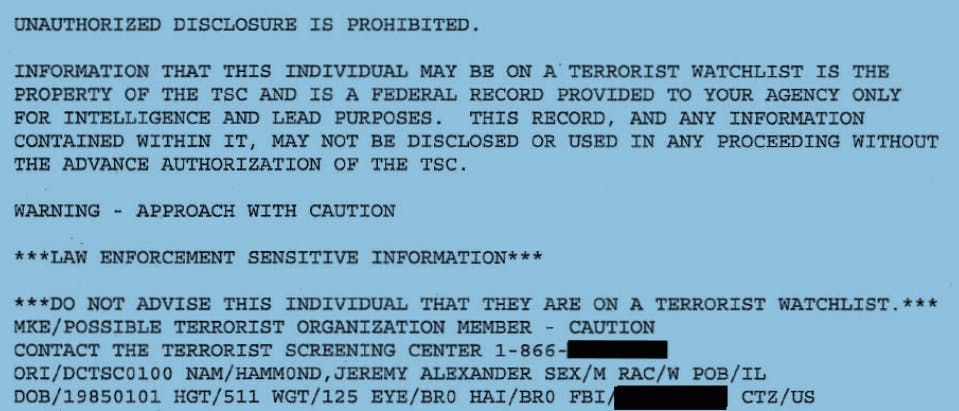The Federal Bureau of Investigation put Anonymous hacker Jeremy Hammond on a secret terrorist watchlist, according to confidential records obtained by the Daily Dot.
The records further reveal how the FBI treats cybercrimes and shines a rare light on the expanding definitions of terrorism used by U.S. law enforcement agencies.
A leaked document originating from the New York State Division of Criminal Justice Services (DCJS) reveals that Hammond was considered a “possible terrorist organization member,” and indicates that he was placed on the multi-agency Terrorist Screening Database (TSDB), alongside individuals suspected of ties to Al Qaeda, Somalia-based extremists al-Shabaab, and Colombia’s leftist FARC guerilla movement.
Arrested in March 2012, Hammond is currently serving the remainder of a 10-year prison sentence for his involvement in a series of high-profile cyberattacks targeting federal agencies, private government contractors, and police departments.
In December 2011, Hammond stole roughly 5 million confidential emails and thousands of credit card numbers from Austin-based intelligence publisher Stratfor, a devastating hack that was later revealed to have been orchestrated by an FBI informant. The emails were later published by WikiLeaks.
Journalist Barrett Brown, likewise noted for his involvement with Anonymous, was sentenced to 63 months in prison last month in part for his association with Hammond.
Addressed to the Manhattan U.S. Attorney’s office and labelled “destroy after use,” a print-out of Hammond’s criminal history reveals instructions intended for law enforcement during an encounter. “Do not advise this individual that they are on a terrorist watchlist,” it says.
Had police ran Hammond’s ID, they would have been advised to immediately contact the Terrorist Screening Center (TSC), a division of the FBI established by President George W. Bush in the wake of 9/11 and the central hub of U.S. terrorist watchlist compilation. Officers are further instructed to not “extend the scope or duration of the encounter,” or to make an arrest “unless there is evidence of a violation of federal, state, or local statute(s).”
“Information that this individual may be on a terrorist watch list is the property of the TSC and is a federal record provided to your agency only for intelligence and lead purposes,” the document says. “This record, and any information contained within it, may not be disclosed or used in any proceeding without the advanced authorization of the TSC.”
The United States has no single definition for “terrorism.” The law, Title 18 of the U.S. Code (Section 2331), describes it as an act “dangerous to human life.” That definition, however, was not “directly applicable” to the approach of the TSC, according to a leaked document published last year by the Intercept. Instead, the TSC redefined terrorism by combining “elements from various federal definitions.” Unlike U.S. law, the TSC’s definition excludes a threat to human life as a prerequisite for terrorist activity.
According to the definition issued by the National Counterterrorism Center (NCTC) in March 2013, in addition to threatening human life, an individual may be nominated to the TSDB watchlist for suspected “acts dangerous to … property, or infrastructure” that appear intended to “intimidate or coerce a civilian population,” or “influence the policy of a government.” Individuals seen as facilitating or supporting “terrorist activity,” violent or not, may also be added to the TSDB watchlist.
Carey Shenkman, a constitutional lawyer in New York City, said the TSC’s definition appears “strikingly over-broad.”
“Nonviolent political speech, or even just supporting that speech, can land someone on a watchlist,” Shenkman said. “The problem is even worse in the digital realm, where ‘property’ can mean any bit of information. Harm to property could mean virtually anything.”
“If we want to use the terrorism database to protect human life, it’s only effective if it is narrowly focused on people who actually pose a threat to human life,” former FBI agent Michael German, now a fellow at the Brennan Center for Justice, told the Daily Dot.
“The FBI has long used terms like cyberterrorism that create more ambiguity than they do clarity,” German said. “They’re really just trying to make those types of investigations go up the level of priority—which may or may not be justified—but whether it actually serves as an effective security measure is another question.”
The Intercept previously reported that as of November 2013, as many as 700,000 people were on the TSDB watchlist, according to a U.S. counterterrorism official familiar with the data.
The FBI did not respond to the Daily Dot’s request for comment in time for publication.
Clarification: An earlier FBI surveillance photo showed Hammond’s residence but not Hammond. We have updated this article with a new photo.
Additional reporting by Dan Stuckey and Andrew Blake
Photo via Federal Bureau of Investigation (FBI)




